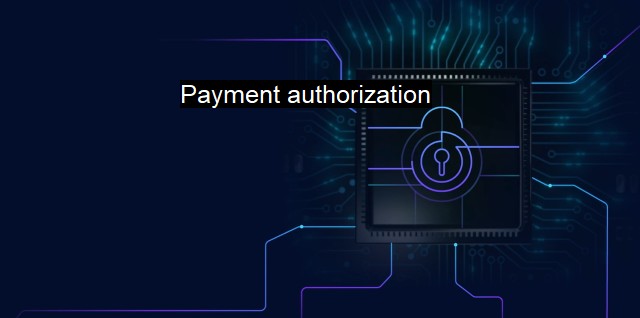What is Payment authorization?
Protecting Online Transactions: Understanding the Crucial Role of Payment Authorization in Cybersecurity Efforts
Payment authorization is a must-know term that is of paramount significance. It is a process that involves confirming or validating that a form of payment, such as a credit or debit card, has suitable funds to cover the transaction. This authorization is significant, more so in the online space, where risk and potential threats are common, arising from malware, Trojan horses, and hackers, among other threats.A payment authorization happens when a cardholder executes a financial transaction using their credit card. It involves the cardholder's bank, known as the issuer, receiving a request to authenticate or authorize that the transaction is valid and can therefore proceed. This authorization checks for sufficient funds, and it also validates whether the card or cardholder's account is in good standing. Often, a hold equivalent to the transaction amount is placed on the account until the transaction closes, effectively reducing the available credit limit or balance for that duration.
In terms of its context payment authorization forms a critical part of secure online transactions. Phishing attacks, where the attacker pretends to be a trustworthy entity to trick the targeted individual into providing sensitive information, can lead to unauthorized transactions. While an antivirus program can ward off such attacks, proper payment authorization protocols are necessary to further enhance security. An adequately protected and safe payment authorization process can defer such security risks, thereby preventing unauthorized transactions and potential financial loss.
Ensuring secure payment authorization requests and responses is central to anti-fraud measures in the digital payments ecosystem. Using standard encryption and digital certificates, sensitive data such as credit card numbers are transformed into unreadable code that can only be decrypted by authorized entities, thereby safeguarding online transactions.
More robust payment authorization methods that incorporate multiple levels of security have emerged in response to digital threats, including two-factor authentication (2FA). This is where users are required to confirm their identities using two separate verification methods. The most common example is a password and a one-time code sent to a registered phone number. Generally, cybersecurity systems and antivirus software work together to secure two-factor authentication methods, providing an unbroken security layer that protects sensitive data from potential threats.
Besides, implementing antivirus solutions, businesses and retailers need to respect the Payment Card Industry Data Security Standard (PCI DSS). This standard determines how organizations should handle cardholder information to enhance security and prevent fraud. Antivirus software should be compliant with it. Any system storing, processing, or transmitting cardholder data should have a secured operating system and operate with anti-malware software.
Payment authorization and cybersecurity are two interconnected strands that together deliver a safe environment for digital transactions. Antivirus software plays a crucial role in shielding online payment systems from malware and other cyber threats, ensuring that payment authorizations are securely handled and information is protected.
For a fully secure ecosystem antivirus software needs to work hand in hand with other cybersecurity measures, such as encryption, two-factor authentication, regular software updates, and compliance with established data protection protocols. In this manner, the entire payment authorization process becomes a vital bastion against fraud, theft, and other forms of cybercrimes. Crafting a robust integrated cybersecurity infrastructure keeps at bay unauthorized interfaces, fortifying the entire payment authorization system.
Hence, payment authorization is not just about authorized financial transactions; its umbrella stretches much wider to encapsulate multiple levels of security systems in tandem with cybersecurity, more specifically, antivirus protections. Conclusively, it safeguards consumers, merchants, and the financial ecosystem against a wide array of digital threats in this digital age, where every transaction, from every corner, from various devices, can be a potential threat vector.

Payment authorization FAQs
What is payment authorization in the context of cybersecurity and antivirus?
Payment authorization refers to the process of verifying and approving a transaction before it is allowed to proceed. In cybersecurity and antivirus, payment authorization is a security measure put in place to prevent unauthorized transactions, fraud, and other malicious activities.What is the role of payment authorization in protecting against cyber threats?
Payment authorization plays a critical role in protecting against cyber threats by ensuring that all transactions are legitimate and authorized. It helps to prevent fraud, identity theft, and other cyber attacks, and can be used to monitor and detect unusual or suspicious activity.What are the different types of payment authorization methods used in cybersecurity and antivirus?
There are several different types of payment authorization methods used in cybersecurity and antivirus, including two-factor authentication, one-time passwords, biometric identification, and transaction monitoring. These methods help to ensure that only authorized users are able to initiate transactions, and that those transactions are legitimate and secure.What should I do if I suspect that my payment authorization has been compromised in the context of cybersecurity and antivirus?
If you suspect that your payment authorization has been compromised, you should immediately contact your bank or financial institution and report the incident. They will be able to investigate and take steps to protect your account and prevent future unauthorized transactions. You should also consider changing your passwords and monitoring your accounts for any suspicious activity.| | A | | | B | | | C | | | D | | | E | | | F | | | G | | | H | | | I | | | J | | | K | | | L | | | M | |
| | N | | | O | | | P | | | Q | | | R | | | S | | | T | | | U | | | V | | | W | | | X | | | Y | | | Z | |
| | 1 | | | 2 | | | 3 | | | 4 | | | 7 | | | 8 | | |||||||